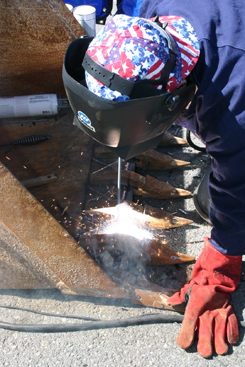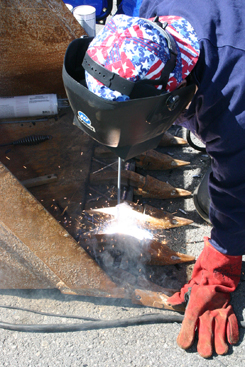Hardfacing: Compact Equipment Can Benefit, Too
Hardfacing isn’t just limited to heavy equipment. This welding technique, which involves adding filler metal deposits to the surface of the base material of a piece of equipment, can extend the life of parts on compact equipment, too — for up to 75 percent less cost than replacement parts. On older equipment, hardfacing can return parts like buckets and teeth to a nearly new condition, and on new equipment it can protect them for up to 300 percent longer than non-surfaced parts.

protect compact equipment against wear,
for less money.
Other benefits from hardfacing include reduced downtime and reduced need for storage space and inventory. Because parts last longer, there are fewer shutdowns necessary to replace parts and there is also less need to store replacement parts when worn parts can be rebuilt.
Gaining these benefits, however, requires knowledge about hardfacing techniques, the type of wear that the equipment will experience in the field and more.
The basics: techniques and processes
Hardfacing involves one of two techniques: build-up or overlay. Based on the equipment needs, some may want to use a combination of both. The combination of the two techniques can be completed repeatedly provided that the part or equipment still remains sound.
The build-up technique (placing layers of welds on top of each other) returns older equipment back to its original dimensions after it has been worn by impact or abrasion; compact equipment is mostly subject to the latter. The overlay technique adds a layer of protective filler metal deposits to protect against metal loss.
Stick (SMAW) and flux-cored (FCAW) welding are the most common processes for hardfacing on compact equipment. As with any welding process, both have their advantages and disadvantages. Stick welding, for example, is ideal for hardfacing in the field since it doesn’t require an additional wire feeder. It also offers all-position welding capabilities. Stick electrodes, however, have a low efficiency (due to stub loss), a relatively low deposition rate (approximately 1 to 7 pounds per hour) and may require several weld layers to obtain maximum wear properties.
For applications that require higher deposition rates or that need to be completed faster, flux-cored welding may be the better option. This process provides higher deposition rates (approximately 4 to 25 pounds per hour) and the process is relatively easy to use. But unlike stick welding, flux-cored welding is limited to flat and horizontal positions.
Wear factors: abrasion
Abrasion accounts for the majority of compact equipment wear. There are three main types: low-stress scratching, high-stress grinding and gouging abrasion.
1. Low-stress scratching abrasion: This type is the least severe form of abrasive wear. It occurs when the base metal on the equipment slowly wears away from the scouring action of materials such as dirt and gravel. Carbide or chrome-carbide filler metals best protect against this type of wear.
2. High-stress grinding abrasion: This type of abrasion results from the repeated crushing and grinding of materials against the equipment. Filler metals containing austenitic manganese, martensitic irons or titanium carbides offer the best protection against it.
3. Gouging abrasion: This abrasion occurs when large objects, such as rock, press against the equipment and create grooves. Filler metals containing high carbide alloys and supported by austenitic manganese provide good impact resistance and are a good choice to protect against gouging abrasion.
Other important factors
Knowing about the part’s base material and the desired surface finish is also important to gaining the benefits of hardfacing.
The most common materials to hardface are carbon or low alloy steels. When hardfacing those with higher amounts of carbon and/or alloy content, pre-heat, post-heat or stress relieving treatments may be necessary to prevent cracking since these materials are more brittle. Thicker base materials typically require the same heating considerations.
Austenitic manganese steels also become brittle during the welding process, but they can still be hardfaced. They should not, however, be pre-heated unless the temperature of the part is less than 50 degrees Fahrenheit. During the hardfacing process, take care to keep the base material under 500 degrees Fahrenheit. Exceeding that temperature barrier for an extended period of time increases the steel’s brittleness. Austenitic manganese steels with higher carbon and lower manganese content accelerate this time/temperature reaction.
Regardless of the base material, always employ proper pre-cleaning procedures before hardfacing. Wipe the base material to remove contaminants such as grease, dirt, rust and oil. If necessary, remove old hardfacing layers, as well as cracks, by way of carbon arc (or plasma) gouging or by grinding.
Finally, determine the type of surface finish the equipment requires. Hardfacing filler metals range from easy to difficult to grind, so it’s important to determine the required finish prior to choosing one. If a smooth surface is necessary, measure the time and cost of grinding to achieve this surface versus using a filler metal that has slightly less wear resistance, but provides a smooth finish. A filler metal that can be heat-treated to soften it for machining, and then brought back to the hardness necessary to protect the equipment may also be an option. Or, if relief checks (small checks which do not weaken wear resistance) are an acceptable surface finish, consider a carbide alloy designed to be crack sensitive.
Additional information: overlay patterns
There are three overlay patterns for hardfacing: waffle, stringer and dot. The location of the wear, the type of abrasion and the type of material causing it determine which pattern to use.
1. Waffle pattern (also called herringbone): This pattern is composed of crisscrossed weld beads that form squares. Smaller aggregates like dirt, sand or gravel pack into the squared area to form a protective layer over the equipment’s base metal.
2. Dot pattern: This pattern works well on base metals that are sensitive to overheating and protects well against low-impact, high-abrasive wear. Applying the pattern consists of adding dots to the center of the work piece and working outward to cover the entire area needing protection. The size of the aggregates the equipment encounters will determine the distance between dots. For example, a bucket that scoops larger aggregates requires a more widely spaced dot pattern, whereas equipment encountering smaller aggregates benefits from more closely spaced dots.
3. Stringer pattern: This pattern provides good protection against abrasion and consists of weld beads that run parallel to one another. Stringer beads for smaller-grained materials can be placed 0.25 to 1.5 inches apart, perpendicular to the flow of the materials. For larger-grained materials, the stringer beads should be placed parallel to the flow of the material.



